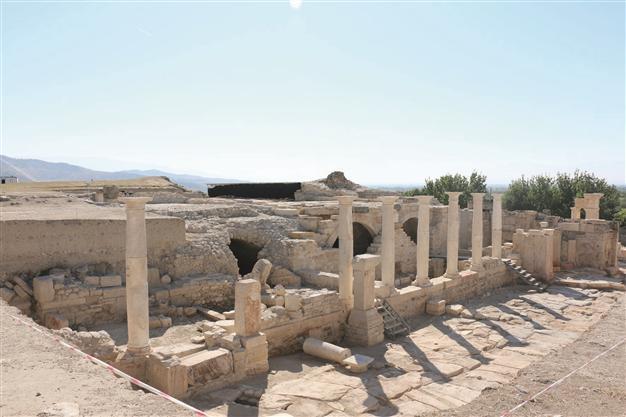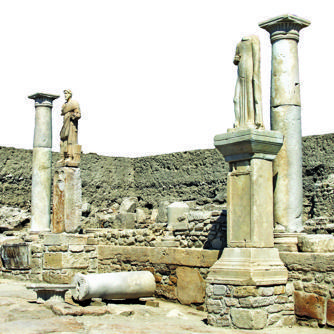Administrators of late ancient era come to light
DENİZLİ - Anadolu Agency

The sculptures, which are made of marble and
onyx, are 1.7-1.8 meters- high, the average
size of a human. Most of the sculptures were
found complete. AA photos
Excavations on the ancient city of Tripolis in the western province of
Denizli’s Buldan district have unearthed seven life-size marble
sculptures. The excavations have been carried out by Pamukkale
University Archaeology Department.
Head of the excavations
Bahadır Duman said the ancient city of Tripolis was located in the
junction point of the Phrygia, Caria and Lydia regions during the
Hellenistic era. He said they had been working for four months on the
“road of pillared galleries” in the east side of a 2,500 square-meter
market place. He said Anatolia had many sculptures from the 1st, 2nd and
3rd centuries, but there were fewer from the 5th century.

“The
ancient city of Tripolis is quite a lucky place in terms of sculptures.
We have found fine artworks. We have completely unearthed one of the
pillared galleries and begun its restoration. There are 25 pillars in
this closed pillared gallery and all of them collapsed during an
earthquake. They survived thanks to erosions. The floor of this gallery
is covered with travertine. The pillars are nearly three-meters-high and
were protected with a roof,” he said.
Duman said they had also
found a multiple-stage platform in the continuation of the pillared
galleries, estimating that people used to come to there for commercial
purposes.
“Another interesting finding is, perhaps for the first
time in Turkey, there are seven sculptures, found around the pillared
gallery and marketplace. The sculptures are 1.7-1.8 meters-high, the
average size of a human. Most of them were found complete. They are made
of marble and onyx. We have discovered an important sculpture
collection, unique in ancient Anatolian archaeology. We will find the
rest of the sculptures during further excavations,” Duman said.
According to their estimations, they will unearth 15-20 sculptures from
the site, he added.
He said the sculptures dated back to the 5th
century A.D., when the Roman Empire was still powerful in Tripolis. He
said, “These are the sculptures of the administrators and notable people
of the city. Some of them are the sculptures of religious leaders. We
can say new information about the administrators of that ancient era has
now come to light.”

 “The
ancient city of Tripolis is quite a lucky place in terms of sculptures.
We have found fine artworks. We have completely unearthed one of the
pillared galleries and begun its restoration. There are 25 pillars in
this closed pillared gallery and all of them collapsed during an
earthquake. They survived thanks to erosions. The floor of this gallery
is covered with travertine. The pillars are nearly three-meters-high and
were protected with a roof,” he said.
“The
ancient city of Tripolis is quite a lucky place in terms of sculptures.
We have found fine artworks. We have completely unearthed one of the
pillared galleries and begun its restoration. There are 25 pillars in
this closed pillared gallery and all of them collapsed during an
earthquake. They survived thanks to erosions. The floor of this gallery
is covered with travertine. The pillars are nearly three-meters-high and
were protected with a roof,” he said.